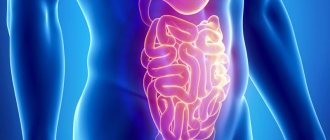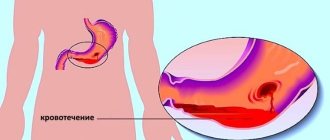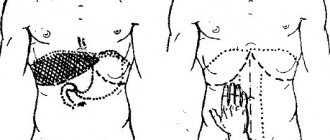Dumping syndrome - causes
In healthy people, food moves from the stomach to the intestines within a few hours. However, with early dumping syndrome, food particles move too quickly into the duodenum. This causes fluid to move rapidly in the intestines, causing discomfort, bloating and diarrhea.
Late dumping syndrome occurs when large amounts of insulin are released. Insulin
is a hormone that helps the body absorb sugars. Increased levels of insulin in the bloodstream lead to decreased blood sugar levels.
The most common cause of dumping syndrome is surgery. This condition occurs in at least 15% of people after undergoing surgery.
Forecast
The prognosis for life is difficult in the case of advanced dumping syndrome , when the body critically suffers from disturbances in vitamin, water-salt, protein, fat and carbohydrate metabolism. In other cases, dumping syndrome can be successfully stopped.
In patients who have undergone surgical treatment of stomach diseases, dumping syndrome is a concern in the first year after surgery, then its manifestations subside, and the prognosis improves.
Kovtonyuk Oksana Vladimirovna, medical observer, surgeon, consultant doctor
11 total today
( 166 votes, average: 4.65 out of 5)
Neonatal sepsis is a serious condition
Relaxation of the diaphragm, its relaxation: what is it?
Related Posts
Phases of dumping syndrome
There are two phases:
Early dumping syndrome
- symptoms begin 10-30 minutes after eating.
Late dumping syndrome
- symptoms begin 2 - 3 hours after eating.
About 75% of people with dumping syndrome have early dumping syndrome, and about 25% have late dumping syndrome. Some people have both phases.
Symptoms of early dumping syndrome
Symptoms appear immediately after eating, especially if the food was sweet. People with early dumping syndrome may experience:
- diarrhea;
- dizziness;
- bloating;
- increased heart rate;
- nausea;
- stomach ache;
- vomiting
Symptoms of late dumping syndrome
The following symptoms may occur within 3 hours after eating:
- dizziness;
- weakness;
- hunger;
- increased heart rate;
- sweating
Symptoms
The degree of the syndrome affects the symptoms of the disease. The mild stage of the disease after gastrectomy is characterized by the following manifestations of digestive disorders, which appear 15 minutes after eating:
- diarrhea;
- weakness throughout the body;
- desire to rest, lie down;
- slight dizziness;
- fainting state;
- hot flashes;
- increased sweating;
- headache.
After resection or removal of the stomach, the middle stage of the disease is characterized by attacks that occur 2 to 4 times a week, lasting about an hour after eating different foods. Patients note the following symptoms of dumping syndrome at this stage:
- feeling of fullness in the stomach, causing discomfort;
- nausea;
- characteristic rumbling in case of indigestion;
- diarrhea;
- spasms;
- weakness;
- severe headaches;
- the heart rate increases by 25 beats per minute.
The severe stage of dumping syndrome is characterized by indigestion, which leads to a catastrophic loss of body weight due to the appearance of pain after eating any food. Progression of the disease leads to the development of hypoglycemia due to increased blood glucose levels. This stage is characterized by:
- feeling of hunger;
- profuse sweating;
- impaired coordination of movements;
- loss of consciousness, fainting;
- impaired concentration;
- exhaustion due to food restriction.
The severity of these symptoms depends on the individual characteristics of the body.
Diagnosis of dumping syndrome
To diagnose dumping syndrome, a doctor must review your medical and family history and evaluate signs and symptoms. A blood glucose tolerance test is also performed, a laboratory test that measures blood sugar levels. A gastric emptying test is performed - this test method evaluates the speed and quality of gastric emptying. The passage of radioactive material through the digestive system is monitored by a scanner to see how quickly food leaves the stomach and enters the small intestine.
Photo: iStudentNurse
Diagnostics
Diagnosing dumping syndrome is not difficult, given the patient’s characteristic complaints related to food intake, and in most cases, the fact that the patient has previously been operated on for stomach disease.
In doubtful cases, the following have diagnostic value:
- laboratory tests;
- X-ray of the gastrointestinal tract using a contrast agent.
In case of severe disorders of the nervous system (especially the mental sphere), consultation with a neurologist and psychologist is indicated for the purpose of differential diagnosis.
In order to correctly determine the severity of dumping syndrome, a glucose challenge test is performed. Before the study, the patient’s blood pressure and pulse rate are measured, blood sugar levels are determined, and the volume of plasma circulating in the body is calculated. Then, in order to provoke dumping symptoms, the patient is injected intravenously with 150 ml of a 50% glucose solution. Wherein :
- if symptoms of a dumping attack have developed, blood pressure, heart rate, blood sugar, and circulating plasma volume are measured again;
- If drug provocation does not lead to an attack, then after 10-15 minutes the test is repeated for a control purpose.
After a few hours, a pool of the following control samples is carried out in order to diagnose a hypoglycemic state.
An X-ray examination with a contrast solution introduced into the gastrointestinal tract through the mouth will help to draw conclusions about what anatomical and functional changes in the stomach and small intestine occurred in the early and late periods after gastrectomy.
In case of dumping syndrome, the following are radiologically determined:
- accelerated emptying of the gastric stump - in this case, about a third of the stomach contents enters the jejunum in the very first minutes, accelerated emptying of the gastric stump is observed (at least a third of the contents immediately enters the jejunum);
- increased peristaltic movements of the small intestine, which alternates with weakened motility;
- increased motor (motor) activity of the large intestine (this is manifested by diarrhea).
If the stomach has not been resected, radiography with contrast will help determine the dynamics of gastrointestinal motility.
Laboratory diagnostics when diagnosing dumping syndrome are not informative. Its methods are used to determine the degree of deviations that have occurred as a result of this disease. The following deviations may be detected:
decrease in the amount of hemoglobin and red blood cells in the blood;- polyhypovitaminosis (decreased levels of vitamins of all groups);
- disorders of electrolyte-salt metabolism (imbalance of salts and minerals in the blood);
- hypoproteinemia (decrease in the level of protein fractions in the blood);
- steatorrhea (the presence of fatty fractions in the feces due to their reduced absorption of fats in the intestines and their excessive excretion in feces).
It is important to diagnose neuropsychic disorders, which quite often accompany dumping syndrome. Often, such patients develop the following psychopathic syndromes:
- asthenic (the patient cannot cope with the least psychological stress, not to mention stress levels);
- neurasthenic (increased fatigue, irritability, attacks of headaches up to the intensity of migraines occur);
- hysteriform (the reaction is expressed by fits of irritability, expressed by changes in mood - from uncontrollable laughter to uncontrollable crying);
- depressive (any external stimuli do not cause any reaction in the patient, he is lethargic and inhibited, indifferent to things that previously evoked positive emotions);
- hypochondriacal (the patient perceives everything that happens around him through the prism of suspiciousness).
Dumping syndrome treatment
Lifestyle and diet changes can reduce the symptoms of dumping syndrome. More severe cases may require medication or surgery.
To relieve symptoms:
- eat food five to six times a day in small portions;
- do not drink liquids 30 minutes before or after meals;
- drink 8 glasses of water throughout the day, but only between meals;
- lie down for 30 minutes after eating;
- Consume high-fiber foods such as oatmeal, whole wheat bread, beans, lentils and vegetables;
- limit or avoid foods high in sugar, such as candy, cakes, fruit juice;
- limit or avoid white bread, white rice and pasta;
- give up alcohol;
- increase your intake of protein, such as lean meats, fish and tofu;
- remove dairy products from the diet, since dairy products contain the sugar lactose;
- Add pectin, psyllium, or guar gum to meals to slow the speed at which food passes through the digestive system.
Drug treatment
If dietary changes do not improve symptoms, your doctor may prescribe an octreotide
. This antidiarrheal drug slows the rate at which food enters the small intestine. It may also interfere with the release of insulin. Adverse reactions to this drug include nausea and vomiting.
Surgical treatment methods
If patients do not respond to other treatments or if symptoms are caused by previous surgery, the doctor may suggest surgery. There are several surgical techniques that can treat this condition. However, doctors warn that corrective surgery is not always successful.
Complications that may arise as a result of the operation:
- problems with nutrient absorption;
- anemia due to lack of vitamin B-12, folic acid, or iron;
- osteoporosis caused by problems with calcium absorption.
Many people with early dumping syndrome recover within a few months, especially if they make changes to their lifestyle and dietary habits.
Prevention and prognosis
Preventive measures after resection in operated patients are aimed at adapting the digestive system and the body as a whole to new anatomical and physiological realities. You should follow the recommendations of your doctor:
- follow a diet;
- promptly relieve neuropsychiatric disorders;
- regularly perform a developed set of therapeutic exercises;
- use a bandage at every meal;
- half an hour's rest in a horizontal position after eating is required;
- avoid stressful situations.
Ignoring the manifestations of dumping syndrome by patients and their loved ones can lead to anemia, protein deficiency, anorexia, vitamin deficiency and even loss of ability to work.
After surgery on the stomach, namely after resection, many patients experience specific complications. According to statistics, post-gastroresection disorders are more common in women than in men. One of these complications is dumping syndrome.
This syndrome occurs after resection. This is a disease of the operated stomach and requires regular professional supervision.
Types of deviation
Dumping syndrome after gastrectomy has several forms. According to the time of development, the disease is distinguished: early and late. In the early form of the disease, symptoms appear within 10-20 minutes after eating food. With the late form, symptoms appear only after two hours.
Patients often experience discomfort after eating
The disease has three degrees of severity - mild, moderate and severe. Features of the forms are described in the table.
| Degree | Peculiarities |
| Lightweight | Symptoms occur only against the background of consumption of dairy and sweet products. The attack lasts no more than half an hour. |
| Average | An attack occurs against the background of eating any food product. Lasts at least an hour. |
| Heavy | The attack is pronounced. Lasts at least 1-2 hours. Needs urgent medical attention. |
In the presence of degrees 1-3, the patient always loses a certain amount of body weight, and attacks are always accompanied by unpleasant symptoms.
Some experience sudden weight loss
The main causes of the disease
The main reason for the development of dumping syndrome is the entry into the upper parts of the small intestine of a poorly processed food bolus in the stomach with a large number of large particles and high osmolarity.
This causes stretching of the walls and stimulation of receptors localized in the cells of the intestinal wall, as well as the release of biologically active compounds from the cells of the mucous membrane - histamine, serotonin, kinins, vasoactive intestinal polypeptide, etc.
In addition, the transition of intercellular fluid into the intestinal lumen reflexively increases to normalize the osmotic pressure of chyme. As a result, blood vessels dilate, especially those supplying blood to the intestines, the volume of circulating plasma decreases, and intestinal motor activity increases.
A decrease in circulating plasma volume by 15-20% is decisive in the occurrence of symptoms such as:
- weakness, dizziness, fainting, collapse;
- from the cardiovascular system - palpitations, instability of blood pressure at the first stage with a tendency to decrease and then increase, mainly systolic;
- intestinal colic and diarrhea - develop as a result of increased motility of the small intestine.
Changes in the rate of secretion and composition of pancreatic juice, as well as bile, cause disruption of food digestion. This is facilitated by the acceleration of chyme reaching the distal parts of the small intestine. As a result:
- Rapid absorption of mono- and disaccharides, which causes a significant compensatory increase in insulin in the blood;
- Reduced degree of hydrolysis (digestion) of proteins, fats, carbohydrates (polysugars);
- Progressive increase in weight loss (weight loss),
- The occurrence of polyavitaminosis is due to insufficient vitamin content.
- Development of dystrophy, anemia.
Long-term inadequate stimulation of the insular apparatus of the pancreas increases the risk of developing type II diabetes mellitus.










